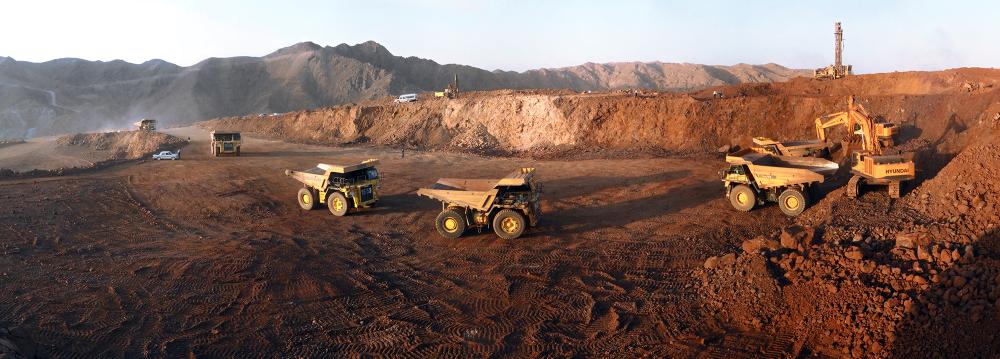Limiting iron ore exports will weaken the already struggling domestic miners and cause Iran to lose its foothold in established export markets, the head of Iranian Mines and Mining Industries Development and Renovation Organization said.
“The world is not going to wait for us while we tinker with export tariffs,” Mehdi Karbasian was also quoted as saying by Donya-e-Eqtesad economic daily.
The Iranian government plans to slap duties on the export of a number of unprocessed minerals, including iron ore, as of the next fiscal year (to start March 20, 2017). The plan stipulates a 5-15% stepwise export tariff raise over a three-year period on zinc, lead, marble, chrome, manganese ores and their concentrates, iron pyrite ash, products made using direct lump iron ore reduction and granulated iron ore.
Iran’s granulated iron ore exports are on the rise. The country shipped 15.15 million tons of granulated iron ore valued at $581 million during the 10 months to January 19, indicating an over 50% growth compared with last year’s corresponding period.
Government officials, however, do not see rising exports as a good thing. They hold that iron ore, instead of being exported, must be used by local iron concentrate and pellet-making factories to create higher value-added products.
Iran seeks to become the world’s sixth largest steelmaker by the end of 2025 as per the goals set in the 20-Year Vision Plan (2005-25). The country will require a steady feedstock of iron ore to reach the envisioned 55-million-ton annual output capacity target.
Objection on 2 Grounds
Karbasian, who chairs Iran’s largest state-owned mineral holding, objects to the state narrative on two grounds.
For starters, not all of Iran’s iron ore deposits are high-grade magnetite ores. In fact, most of them are low-content hematite reserves that are unsuitable for steelmaking unless they go through a costly beneficiation process. The low-purity ore would usually yield higher profits if exported.
Second, Iran currently holds more than 3 billion tons of iron ore reserves. As such, iron ore production will exceed domestic demand even if the 55-million-ton steel output target is realized.
“Evidently, the government is not following the right path in enacting policies for this sector. Miners are still grappling with recession and slapping duties on exports will make them even more vulnerable,” he said.
Echoing similar remarks, Qadir Qiafeh, the head of Iron Ore Producers and Exporters Association, has warned against the consequences of isolationist trade policies on small, private miners.
According to IROPEX, there are 156 iron ore mines across the country. Over 60% (93) of them hold less than 1 million tons of ore and are mostly operated by the private sector. Furthermore, 26% (41) have 1-10 million tons, 4% (7) hold 10-50 million tons and 5% (8) boast reserves of more than 50 million tons. Larger mines are either entirely state-owned or run by quasi-state entities.
Small and medium iron ore mines account for only 5% of Iran’s total reserves, while constituting 24% of Iran’s total annual ore production. Only 19 mines are currently operational out of a total of 156, indicating an 84% decline in the number of active mines compared to 2013–the sector’s boom period.
According to Qiafeh, the government’s standard practice, at a time when a sector is grappling with recession, should be to accelerate its revival by offering incentives such as tax exemptions and export awards.
In Iran, however, the exact opposite scenario is the case. The government, short on budget due to low oil prices and economic stagnation, has opted to boost revenues by raising taxes on struggling businesses.
IROPEX intends to boost ore exports to 15 million tons by the end of the current year before the new regulations kick in.
In spite of the Iranian government’s policy to halt the export of raw materials, customs statistics show a sharp increase in iron ore exports in the nine months to December 20.
Exports Jump in Runup to Deadline
Statistics show Iranian miners exported 13.08 million tons of iron ore in the period, a 45% year-on-year increase.
Iranian miners believe the trend will grow, at least until March.
Some experts argue that the planned duty may not become effective at all because the cash flow from iron ore exports is essential for Iranian mining, both for private miners and semi-governmental iron ore producers.
About 34% of 7.09 million tons of concentrated iron ore produced by Golgohar, Iran’s largest iron ore miner, have been exported in the nine-month period, representing more than 30% of the company’s total income.
In 2015, Iran exported 14.8 million tons of iron ore, down 35% compared to 21.8 million tons in 2014, and was ranked the world’s 11th leading exporter of the steelmaking material.
Most of Iran’s iron ore consignments were exported to China. In 2015, exports to China decreased by 40% from 2014 to 13.2 million tons owing primarily to the prevailing low global iron ore prices.


